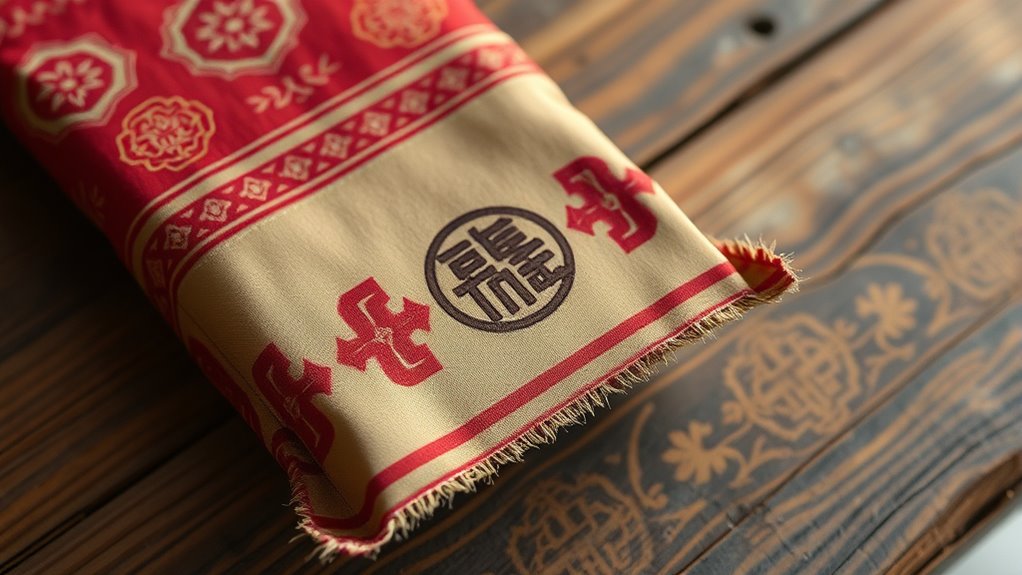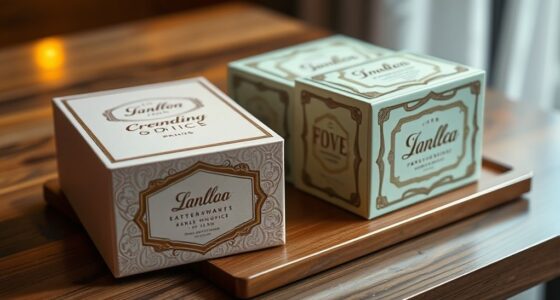To connect with your roots through packaging, incorporate cultural symbols, motifs, and folklore that tell meaningful stories. Use custom designs featuring traditional patterns, legendary figures, or mythic scenes to evoke authenticity and heritage. This approach creates an emotional bond, making your brand stand out while respecting cultural identities. When you explore these storytelling elements further, you’ll discover ways to craft unique packaging that truly resonates with consumers’ sense of tradition and history.
Key Takeaways
- Incorporating traditional motifs and symbols in packaging visually communicates cultural identity and heritage.
- Folklore narratives and mythic elements in packaging tell compelling stories that connect consumers emotionally.
- Custom designs evoke authenticity, celebrating cultural roots and fostering a sense of belonging.
- Multi-layered storytelling through visuals promotes cultural exchange and deeper appreciation of traditions.
- Thoughtful heritage-based packaging differentiates brands and enhances market appeal by highlighting cultural respect.

Have you ever noticed how packaging can tell a story? It’s more than just a container for a product; it’s a canvas that reflects cultural identity and history. When you see packaging that features custom motifs, you’re witnessing a deliberate choice to highlight specific symbols or patterns unique to a culture. These motifs aren’t random; they’re carefully crafted to evoke connections to traditions, beliefs, and stories passed down through generations. They serve as visual shortcuts, instantly conveying a sense of authenticity and heritage. For example, intricate geometric designs, floral patterns, or animal symbols can all be tailored to represent a community’s artistic language. This personalization makes the packaging resonate more deeply with consumers who value cultural roots, creating a bridge between tradition and modern marketing. Additionally, the use of color accuracy in design can enhance the visual storytelling, making cultural elements more vivid and impactful. Folklore narratives are equally powerful storytelling tools embedded into packaging design. When a product’s packaging incorporates elements of folklore, it invites you to explore stories that have shaped a culture’s worldview. These narratives might be represented through illustrations of legendary figures, mythic creatures, or scenes from traditional tales. By doing so, the packaging becomes a storytelling device, sparking curiosity and emotional engagement. You might find yourself drawn into a story that explains the origins of a product, like a legend about a hero or a mythical event, making the experience more memorable. It’s a way to preserve and share stories that define a community’s identity, giving consumers a sense of belonging and pride. Using custom motifs and folklore narratives together creates a layered storytelling experience. It’s not just about aesthetics; it’s about conveying meaning. When you pick up a product with such thoughtful design, you’re participating in a cultural exchange. The packaging invites you to learn about different traditions and histories, fostering appreciation and understanding. For brands, this approach isn’t just marketing; it’s a commitment to honoring and promoting cultural heritage. It allows them to stand out in a crowded marketplace by offering authenticity and a story worth sharing. So, next time you see packaging that feels rich with symbolism or storytelling, remember that it’s more than visual appeal — it’s a tribute to the culture’s unique voice, carefully woven into every detail to connect with you on a deeper level.
Frequently Asked Questions
How Do I Choose Which Cultural Elements to Feature?
You should choose cultural elements that resonate with your brand’s story and audience. Focus on authentic cultural symbols and motifs that reflect genuine heritage, ensuring cultural authenticity. Incorporate visual symbolism that visually communicates the cultural significance and connects emotionally. Research thoroughly, respect cultural meanings, and avoid stereotypes. By thoughtfully selecting authentic symbols and imagery, your packaging will tell a compelling story that honors the culture while appealing to your customers.
What Are Common Mistakes to Avoid in Cultural Storytelling?
You should avoid cultural misrepresentation and stereotypes pitfalls when telling stories. Don’t assume you understand a culture fully; instead, do thorough research and consult cultural experts. Steer clear of clichés or exaggerated portrayals that reinforce stereotypes. Respect authenticity, and be mindful of sensitivities. By doing so, you guarantee your storytelling is respectful, accurate, and engaging, fostering genuine connections without offending or misinforming your audience.
How Can Packaging Be Eco-Friendly While Incorporating Heritage?
Did you know 73% of consumers prefer eco-friendly packaging? To incorporate heritage sustainably, use eco-friendly materials like biodegradable paper or recycled fabrics that reflect your cultural story. Prioritize ethical sourcing by partnering with local artisans and suppliers, ensuring your packaging supports community livelihoods. This approach not only preserves your cultural identity but also reduces environmental impact, resonating with conscious buyers who value authenticity and sustainability.
What Legal Considerations Exist for Using Cultural Symbols?
You need to consider copyright infringement and cultural appropriation when using cultural symbols on packaging. Make certain you have permission from cultural representatives or communities to avoid legal issues and respect their heritage. Avoid misusing or misrepresenting symbols, which can offend or cause controversy. Research laws and guidelines related to cultural symbols in your target markets, and always approach with sensitivity to maintain authenticity and prevent legal complications.
How Do Consumers Perceive Culturally-Rich Packaging?
You’ll find that consumers often perceive culturally-rich packaging as authentic and engaging, which boosts their connection to your brand. When you highlight cultural authenticity, it fosters trust and respect, encouraging consumer engagement. People appreciate genuine storytelling that respects traditions without stereotypes. By showcasing cultural heritage thoughtfully, you create a positive perception, making your packaging stand out and resonate emotionally, ultimately building loyalty and brand affinity.
Conclusion
As you embrace storytelling with cultural heritage in packaging, you connect your brand to timeless traditions, making it more memorable. Imagine your packaging as a secret passage to the past, like opening a vintage scroll in a world obsessed with TikTok trends. By weaving stories that honor your roots, you create a genuine experience that resonates deeply. So, don’t just sell a product—share a piece of history, and watch your brand stand out like a vintage vinyl in a sea of playlists.









